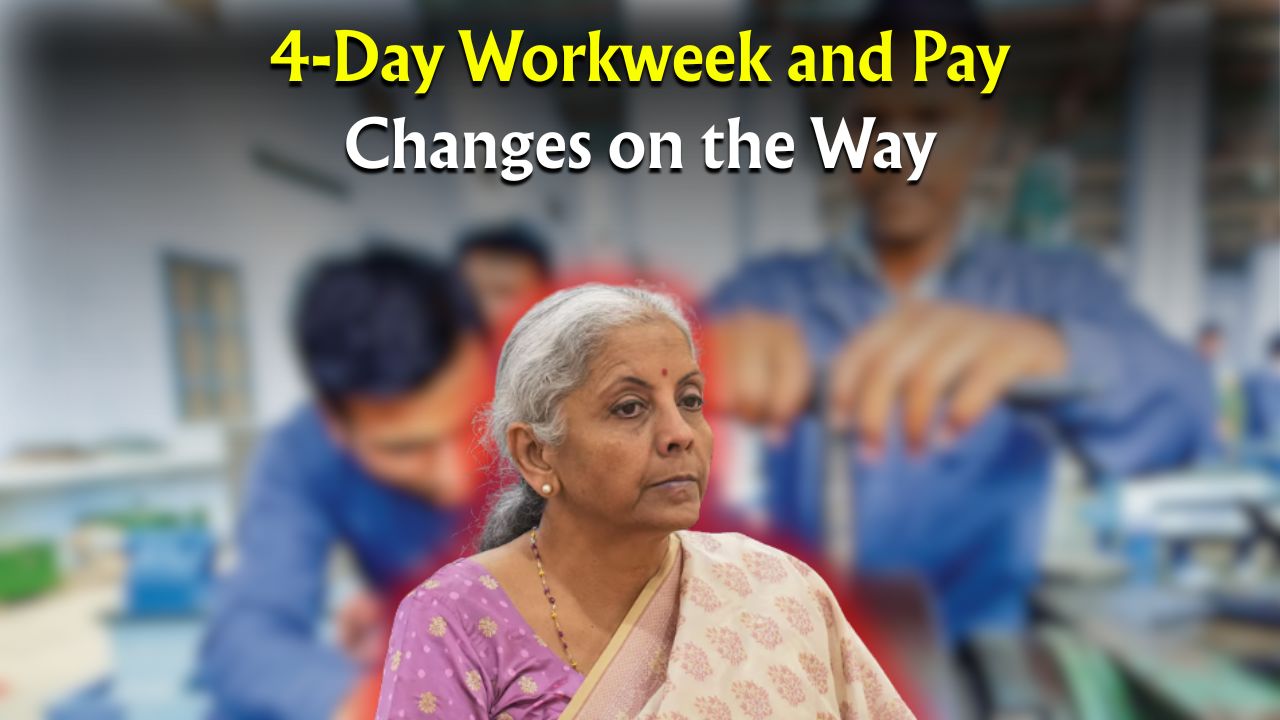The Labour Code 2025 : The government is gearing up for a revolutionary change in employment rules with the upcoming implementation of the Labour Code 2025. One of the most talked-about reforms includes the introduction of a 4-day workweek, alongside significant updates in salary structures, working hours, and employee benefits. These changes are expected to impact millions of private and public sector workers across India.
This article provides a comprehensive breakdown of the new labour code provisions, how the 4-day workweek will function, what it means for employees’ take-home salaries, and what companies need to prepare for.
What is the Labour Code 2025?
The Labour Code 2025 is a consolidation of multiple existing labour laws into a simplified, unified framework. It aims to modernize India’s outdated employment laws and introduce flexible yet fair regulations that benefit both employees and employers.
Key Objectives of the Labour Code 2025:
- Reduce regulatory burden by combining 29 central labour laws into 4 labour codes
- Promote ease of doing business for companies
- Offer greater flexibility in working hours and leave structures
- Provide enhanced social security to employees
The 4-Day Workweek: How It Will Work
Under the Labour Code 2025, companies may soon have the option to adopt a 4-day workweek model. However, this comes with a shift in daily working hours.
 DA Hike April 2025: Massive Salary Hike Expected for Employees – Know How Much DA Will Increase
DA Hike April 2025: Massive Salary Hike Expected for Employees – Know How Much DA Will Increase
Key Highlights:
- Employees can work 4 days a week, provided they complete 48 hours in that week.
- This means a daily shift of 12 hours instead of the standard 8 hours.
- Companies are not mandated to switch to this model—it will remain optional.
- Employees are still entitled to three days of rest if they opt for this compressed schedule.
Benefits and Concerns of the 4-Day Workweek
Advantages for Employees:
- Improved work-life balance
- Reduced weekly commute and stress
- More time for personal development or family
Concerns from Employers:
- Challenges in maintaining productivity during extended workdays
- Potential rise in fatigue or burnout
- Customer service delays in certain industries
Pay Structure and Take-Home Salary Changes
The new labour codes will also bring significant modifications to how salaries are structured—particularly around the definition of “wages.”
Major Salary-Related Changes:
- Basic salary must constitute at least 50% of the total cost-to-company (CTC)
- Contributions to Provident Fund (PF) and Gratuity will rise as they are calculated on the basic wage
- Take-home salary may reduce slightly, while retirement benefits will increase
Table: Old vs New Salary Structure Comparison
| Component | Current Structure | New Structure (Post-Labour Code) |
|---|---|---|
| Basic Salary | ~30-40% of CTC | Minimum 50% of CTC |
| PF Contribution | On basic + allowances | On entire wage structure |
| Take-home Salary | Higher | Slightly reduced |
| Gratuity | Low (if basic is low) | Higher |
| Tax Burden | Lower | Slightly higher |
| Retirement Corpus | Moderate | Significantly higher |
| Employee Benefits | Varies | Standardized |
| CTC Transparency | Low | High |
Impact on Working Hours, Leaves, and Overtime
While the total number of weekly working hours will remain capped at 48 hours, employers will now have the flexibility to decide how these hours are distributed.
Key Provisions:
- Maximum daily working limit: 12 hours (with consent)
- Overtime must be paid at double the normal wage
- Limit of 125 hours of overtime per quarter
- Weekly off is mandatory
- Annual leave entitlement and carry-forward policies may be revised
Table: Key Labour Code Updates Summary
| Category | Current Rule | New Labour Code 2025 Provision |
|---|---|---|
| Workweek | 5-6 days | Optional 4-day workweek |
| Daily Working Hours | 8 hours | Up to 12 hours |
| Weekly Working Hours | 48 hours | 48 hours (no change) |
| Overtime Payment | Often unpaid or irregular | Mandatory at 2x pay |
| Annual Leave | 12-15 days avg. | May be standardized or increased |
| Maternity Benefits | Based on sector | Enhanced across all sectors |
| Gratuity | On completion of 5 years | May be recalculated on higher base |
| Provident Fund | 12% on basic | 12% on revised wage definition |
Implications for Employers and HR Departments
Organizations will have to realign their HR policies, salary breakup structures, and compliance practices in line with the new regulations.
What Employers Need to Do:
- Update employment contracts and salary slips
- Inform and educate employees about the changes
- Upgrade payroll systems to factor in revised definitions of wages
- Ensure compliance with new overtime and leave provisions
Reactions from Employees and Experts
The 4-day workweek has received mixed responses. While many workers welcome the idea of more personal time, others worry about burnout due to longer shifts. Financial experts also highlight the importance of employee awareness regarding salary restructuring.
Employee Feedback:
- “More rest days will help me focus better at work.”
- “I am worried about working 12-hour days—it could be too exhausting.”
Industry Analysts Say:
- “This is a step towards global labour standards but must be implemented carefully.”
- “Proper communication and transition planning will be key for success.”
The Labour Code 2025 brings a bold shift in India’s employment ecosystem, introducing flexibility, transparency, and better long-term benefits for employees. While the 4-day workweek and updated salary structure may take time to fully adapt to, these reforms have the potential to create a healthier, more balanced workforce.
Employees should prepare themselves for the upcoming changes by understanding how their work schedules and take-home salaries might be impacted. Meanwhile, companies must focus on compliance, employee engagement, and strategic HR planning to make the most of these progressive reforms.
The implementation timeline and exact applicability of certain provisions under the Labour Code 2025 may vary based on state adoption and company decisions. Employees are advised to consult their HR departments or official notifications for personalized guidance.








